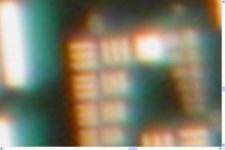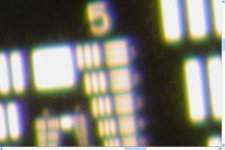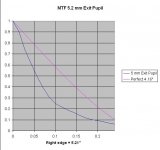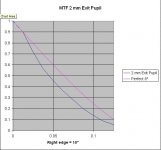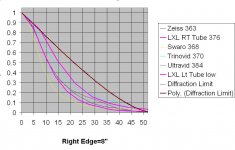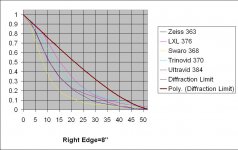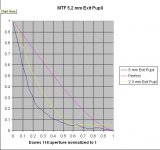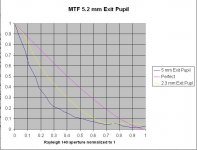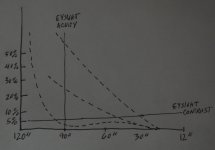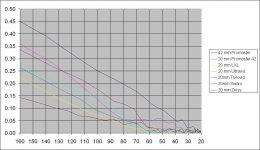Surveyor
The more I understand, the more I understand why I
Hello Henry;
Last night I did a little checking to refresh my memory. I use a different procedure than you since I do not like to modify the lateral and longitudinal magnifications or f ratio. The setup I used was a resolution target collimator, the binocular (8x42 Promaster, reviewed on BF before), an adjustable iris then the camera/booster/eye as a detector.
The results are essentially the same as yours. The measurements are shown below.
Using my eye as a detector with a 6x booster, the resolution (right tube only checked) for full exit pupil, about 5.2 mm, was group 7 element 2 or 3, about 3.4”. Setting the iris to ~2.5 mm the resolution was about group 6 element 3 or 4, about 6”.
I first tried using the camera but the power was insufficient for getting to limiting resolution and neither manual focus or auto focus worked well enough to suit me. The crops are attached. I called these group 6-1=8” at full exit pupil and group 5-1 or 2=14” at 2.5 mm. May be a problem with the edge of stop interfering, notice difference between horizontal and vertical focus at 2.5 mm exit pupil.
Next, I set up a quick MTF measurement. This was done sloppily since I was only interested in the difference between two exit pupils and not in absolute values. As can be seen from the attached plots the 5 mm exit pupil pretty much matches my star test results some time ago. The curve indicates roughly 0.4 wave of error with an extinction resolution about 4”, 6% contrast at 5.2” and 50% contrast at 22.2”. The 2 mm plot indicates approximately a little less than a quarter wave error with extinction around 8”, 6% contrast at 10.25” and 50% contrast at 27”.
I have spent more time making the post than doing the measurements.
Thought this might interest you.
To All;
I still mostly use 8x20’s, mainly because they are always with me. Most of my larger objective binos give me better images but they are inconvenient to have on hand at all times.
Last night I did a little checking to refresh my memory. I use a different procedure than you since I do not like to modify the lateral and longitudinal magnifications or f ratio. The setup I used was a resolution target collimator, the binocular (8x42 Promaster, reviewed on BF before), an adjustable iris then the camera/booster/eye as a detector.
The results are essentially the same as yours. The measurements are shown below.
Using my eye as a detector with a 6x booster, the resolution (right tube only checked) for full exit pupil, about 5.2 mm, was group 7 element 2 or 3, about 3.4”. Setting the iris to ~2.5 mm the resolution was about group 6 element 3 or 4, about 6”.
I first tried using the camera but the power was insufficient for getting to limiting resolution and neither manual focus or auto focus worked well enough to suit me. The crops are attached. I called these group 6-1=8” at full exit pupil and group 5-1 or 2=14” at 2.5 mm. May be a problem with the edge of stop interfering, notice difference between horizontal and vertical focus at 2.5 mm exit pupil.
Next, I set up a quick MTF measurement. This was done sloppily since I was only interested in the difference between two exit pupils and not in absolute values. As can be seen from the attached plots the 5 mm exit pupil pretty much matches my star test results some time ago. The curve indicates roughly 0.4 wave of error with an extinction resolution about 4”, 6% contrast at 5.2” and 50% contrast at 22.2”. The 2 mm plot indicates approximately a little less than a quarter wave error with extinction around 8”, 6% contrast at 10.25” and 50% contrast at 27”.
I have spent more time making the post than doing the measurements.
Thought this might interest you.
To All;
I still mostly use 8x20’s, mainly because they are always with me. Most of my larger objective binos give me better images but they are inconvenient to have on hand at all times.




